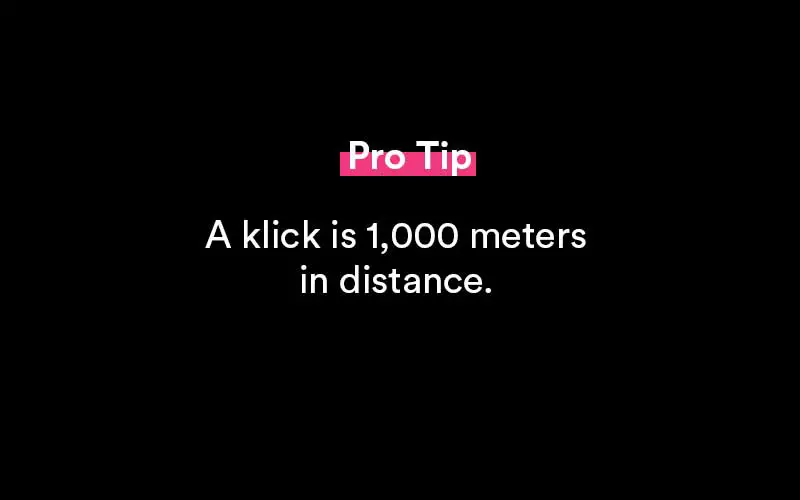How Far is a Klick? Or a Click?
How far is a click? Or how far is a klick? The military frequently use jargon that civilians are unfamiliar with. The phrase klick is one of those terms that the majority of citizens have never heard of. Klick is part of a military metric system that goes back to World War I and is still widely utilized in all branches of the armed forces today.

How far is a klick? How far is a click?
The military uses the word Klick to refer to one kilometer, 1,000 meters, 0.6214 miles, or 3,280.84 feet. A kilometer is a unit of measurement in the metric system that defines the length of a certain distance. We use kilometers to represent particular distances everywhere over the world; however, miles are used instead of kilometers in the United States and some areas of the United Kingdom.
Since World War I, when the British and Americans battled against the French, who employed the metric system to calculate distances, they have used metric systems in different activities. The term kilometer has become a common component of military jargon in the United States as a result of our collaboration with the French.
All maps used by NATO members have been compliant with the NATO Standardization Agreements since the organization's formation. Military members of NATO utilize their own mapping system to identify various places on the globe to the closest meter. In addition to klicks, or kilometers, this method employs kilometers as a measuring unit.

History of the klick
Since World War I, the military of the United States and the United Kingdom have utilized the metric systems while conducting joint operations with the French, who also use the metric system. The maps were created by the French, and after World War I, the term "kilometer" entered the military lexicon of the United States.
From the word "kilometer," the term "klick" was coined. As a result, one kilometer is equivalent to one klick.
Since WWII and the formation of NATO, all maps created and used by NATO nations must adhere to the NATO Standardization Agreements. The Military Grid Reference System (MGRS) is a mapping system standard used by NATO military forces to identify locations on the Earth to the nearest meter.
The term "klick" is a common measure of walking distances among military personnel. When a soldier radios, "We're 10 klicks south of your position," they are referring to a distance of 10 kilometers, or 6.2 miles.

The elevation contour lines on most international maps are also measured in meters.
Australian forces would track their movements by adjusting the gas regulator on an Australian standard-issue military rifle ten times to equal 1000 meters.
Non-military use of the word "click"
When sighting in a weapon, such as a rifle, the phrase "click" (spelled with a "c" instead of a "k") is employed. One "click" on most weapons represents one minute of arc, or, in other words, one inch of distance at 100 yards. Moving the rifle's sight adjustments "one-click" will modify the point of impact for a target 100 yards away by one inch, two inches for a target 200 yards away, and so on.
One Minute of Angle (MOA) at 100 yards is really a little more than one inch (There are 360 degrees in a circle, and each degree is split into 60 minutes). At 100 yards, one degree measures 62.83 inches if we round to the closest 1/100 of an inch. One MOA, or 1/60 of an inch, is 1.047 inches, although rounding it to the nearest inch helps for rapid calculations. The word derives from the clicking sound that occurs when the sight adjustment knobs are adjusted.
Longitude and latitude vs. grid coordinates

The longitude and latitude method is still used on some American maps, and it is also used on the water.
The MGRS, which is measured in meters, is used by the US military, while the Latitude and Longitude are measured in statute miles.
Other common military distance terms
Here are other common military distance terms:
Nautical miles
A nautical mile is a unit of distance used in space, air, and maritime navigation, as well as for establishing territorial seas. On the circle of the globe, one nautical mile equals 1.852 kilometers or 1,852 meters. It's also the same as a minute of latitude.
Knots
A knot is a unit of speed equal to one nautical mile per hour, or 1.852 kilometers per mile, that is used in aviation and nautical military branches.
Kiloyard
A kiloyard is a length measurement equal to 1,000 yards (914 meters). Although this unit of measurement is no longer widely used, certain military divisions continue to refer to 1,000 yards as a kiloyard.
Velocity
Velocity is a word used to describe the speed of a projectile, such as a pellet, bullet, or slug, as measured in relation to the muzzle as it exits the gun's barrel. This method of measuring is commonly used by the Army to define the capabilities of various weapons. Artillery guns, for example, have a low velocity when the velocity is less than 762 m/s, and a high velocity when the velocity is between 914 m/s and 1,067 m/s. When the velocity of tank guns is between 472 m/s and 1,021 m/s, they have a high velocity.
Longitude
Longitude is a word that refers to the vertical lines that link the world's North and South poles. The longitude of a location is defined as the angle formed between the Prime Meridian and a vertical point between the north and south poles.
Latitude
The horizontal lines that run parallel to the Equator are referred to as latitude. Degrees are used to denote latitudes, and each degree is around 69 miles long.
Furlong
A furlong is a unit of measurement. 220 yards, approximately a quarter of a mile.
Rod
A rod is an old English measurement for a distance of 16.5 feet or 5.5 years that is sometimes used in the military.
What is a klick in military terms?
When referring to a klick in the military, it refers to a person sighting in a weapon and is used to indicate a minute of an arc. Because rifle rounds do not move in a straight line, this term is most often associated with sighting-in guns.
Rather, gravity dictates that you go in the shape of an arc. The procedure of sighting-in refers to adjusting the shooter's sight to strike the target at a specific range.
A military soldier, for example, may sight in his gun to strike a target at 200 yards.
What's MGRS?
The Military Grid Reference System (MGRS) is a geocoordinate system used by NATO to find various places on the globe. The Universal Polar Stereographic grid system and the Universal Transverse Mercator grid system were combined to create this system.
Military members will be provided or create an MGRS coordinate, also known as a grid reference, which consists of three components: the grid zone designator, the 100,000-meter square identifier, and the numerical location, while utilizing the MGRS. 4QFJ34891234, for example, is an MGRS coordinate.
One meter, ten meters, one hundred meters, 1,000 meters, and 10,000 meters are among the measurement precisions supported by the Military Grid Reference System. The lower the meter quantity represented by the MGRS coordinate, the fewer numbers will be included in the coordinate.

Popular Resources

Featured
35+ Phone Interview Questions & Best Sample Answers
Phone interviews have become a core part of the process when attempting to find a secured placement for an open position. Companies receive massive responses from potential candidates for any..

Featured
12+ Best Questions To Ask A Recruiter
Concerning a job search, you might receive numerous offers from your recruiters. Before you choose one, you need to assess all the conditions, for which it is vital that you know everything associated with the offered position..

Featured
Answering "What Makes You Unique" In A Job Interview
Answering this question during a job interview requires more than knowing why you are unique as an individual. Yes, the true scientific answer is made up of two main components: your..

Featured
250+ Ice Breaker Questions for Life
An ice breaker question is a question that’s asked from one person to another person in order to act as a conversation starter. It brings a connection...

Featured
10 Best Answers to "What Motivates You?"
Open-ended questions like “What motivates you?” can elicit a deer-in-the-headlights reaction from job candidates if they are unprepared. It’s a broad question and can leave the interviewer..

Featured
Answering "How Did You Hear About This Position" In An Interview
A lot of interviewers ask this question - how did you hear about this position? This way they can judge you if you are a passive or an active job seeker..

Featured
8 Best Thank You Emails After an Interview (Samples, Free Templates)
Writing a thank you note after an interview says a lot about you as a potential employee. Most notably, it says that you care about the opportunities presented..

Featured
Writing a Resignation Letter (How To Write It, Samples)
Writing the perfect letter of resignation is more of an art than it is a science. And we’re going to cover how to master that art form in this full guide..

Featured
How to End a Letter (Example Salutations, Sign Off's)
Knowing how to end a business note or email is an important skill to develop. It helps portray a sense of confidence, respect and tone to your message..
